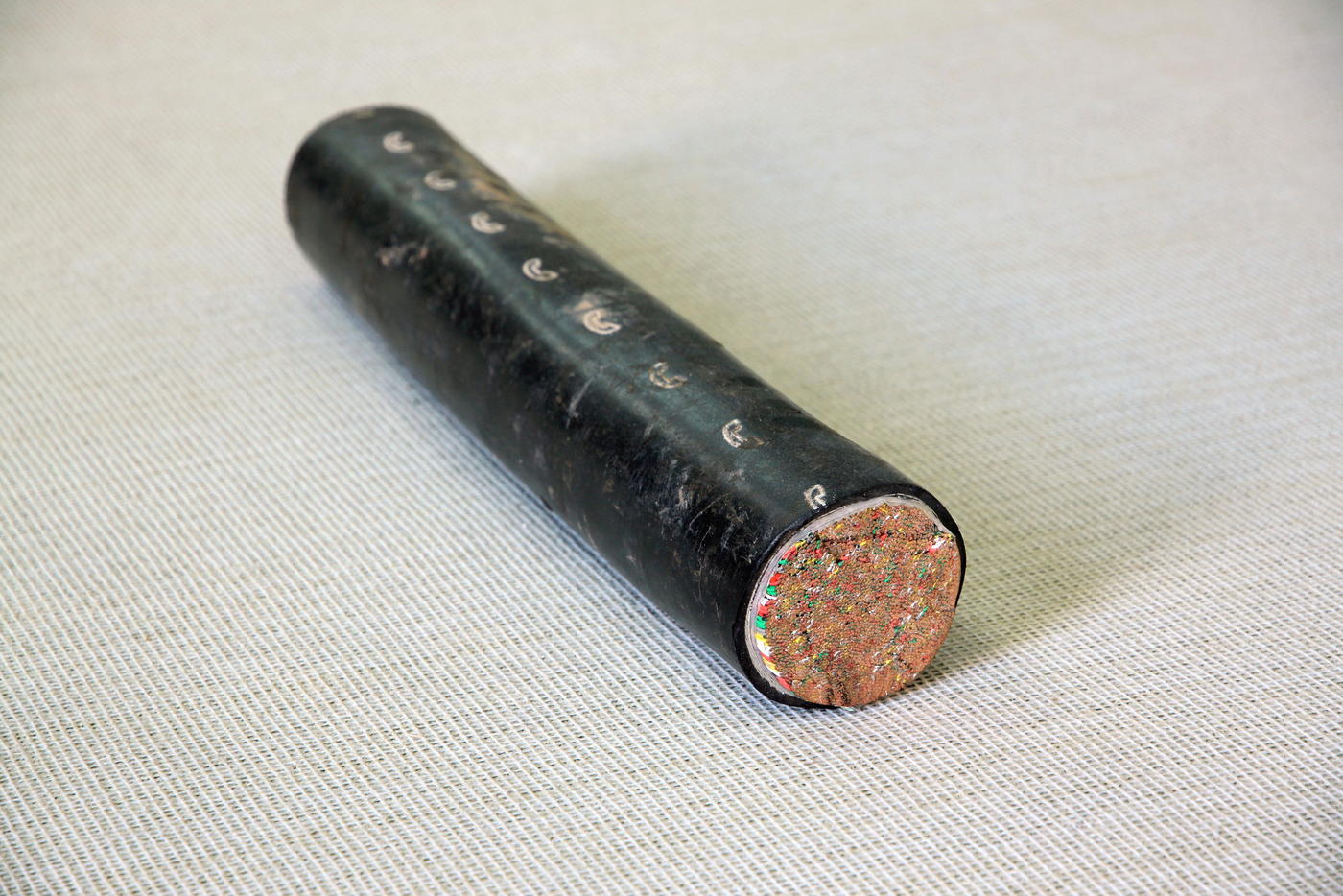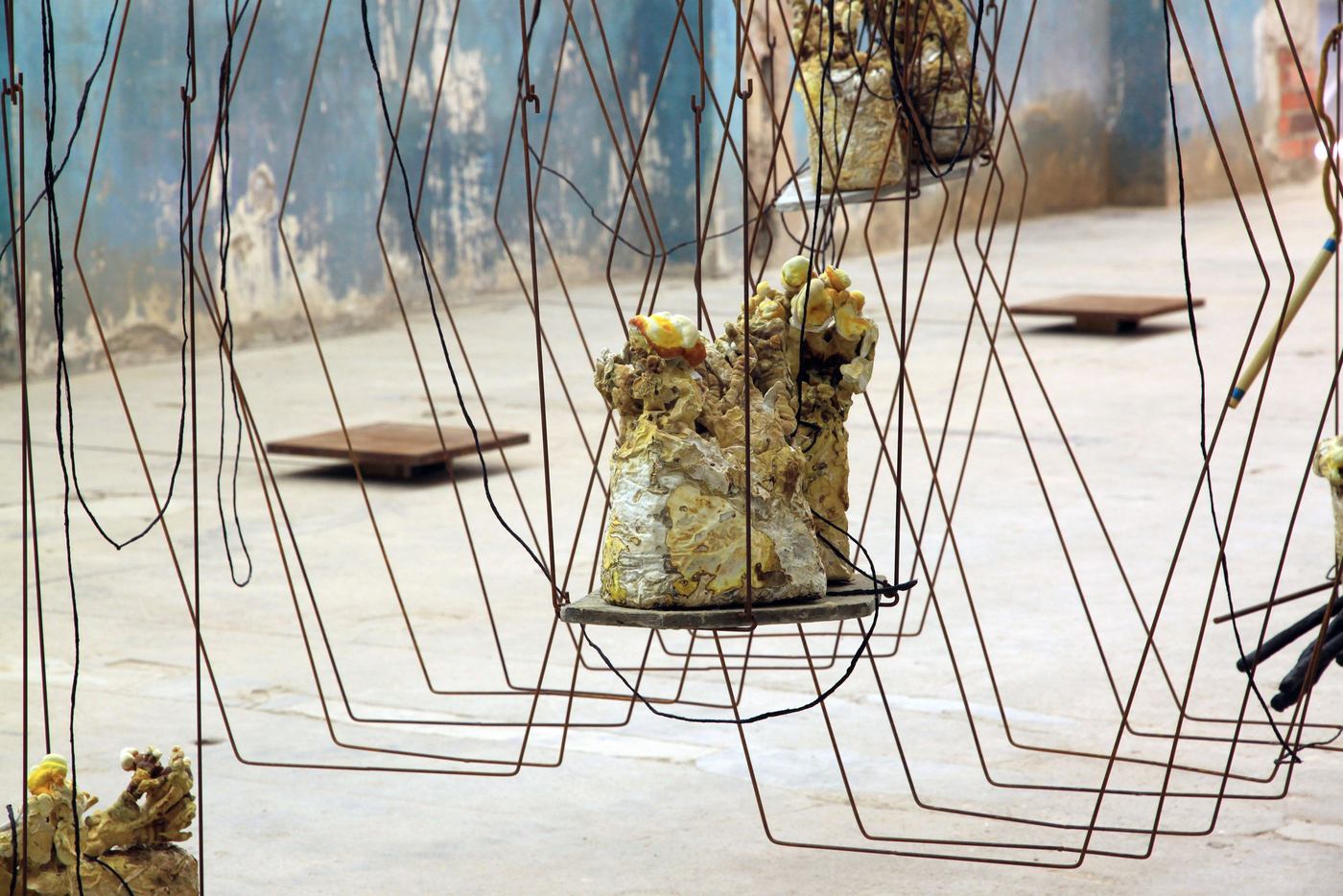Artists: Mark Bain, Nina Canell, Lúa Coderch, Roc Jiménez de Cisneros, Rolf Julius, Lukas Marxt, Fran Meana, Melanie Smith, Iza Tarasewicz
Exhibition title: A THOUSAND HORSEPOWER
Curated by: Sabel Gavaldon
Venue: Trinxet Factory, L’Hospitalet, Barcelona, Spain
Date: June 4 – 19, 2016
Photography: Eva Fabregas, all images copyright and courtesy of the artists
Note: Exhibition guide can be found here
You’re just in time. I hope finding the way to the factory wasn’t too hard. You probably oriented yourself using the GPS on your smartphone. Your tablet’s touchscreen is an inter-dimensional portal connecting faraway spaces and times. The technology it consists of contains a dozen rare earths —chemical elements such as dysprosium, europium, terbium, yttrium, and lanthanum— that have travelled the planet to be here. The tablets used by the first scribes were made of clay collected on the shores of the Euphrates. It is disquieting to think that humanity’s written history goes back just over 5,000 years whilst the half-life of radioactive plutonium is of over 24,000 years. The idea makes one giddy, don’t you think?
It is now 1981. A date like any other. But this year will see the emergence of a new field of research: nuclear semiotics. The US Department of Energy has called upon a heterogeneous group of thinkers and scientists —comprising physicists, engineers, anthropologists, psychologists, even a well-known sciencefiction writer— to form the first Human Interference Task Force. Their duty is to discourage the inhabitants of the future to come close to the 85,000 cubic metres of radioactive waste stored in the desert of New Mexico, 600 metres underground. The challenge is to design a system of signage that might survive a catastrophic future, semantically speaking. A method to communicate with creatures we will never know anything about: “Do not dare to alter the peace of this temple.”
It is an ecopoetic challenge: How might a poem, a drawing, or a sculpture account for human impact on the environment, as its effects echo throughout the millennia? What sort of poetry would have the capacity to document phenomena that vertiginously disperse in space and time, such as global warming, the financial market, or polystyrene particles in the ocean? Questions such as these force us to acknowledge the relativity of the human scale and point to other dimensions: from cosmic events to infinitesimal changes, from nanometric materials to planetary nebulae, from geological time measured in eons to information flows that disappear in a matter of picoseconds.
It is 1784. An insignificant date compared to the deep time studied in geology and paleoclimatology. But 1784 could be the year of the end of the world, as the chemist Paul Crutzen points out. James Watt designed the steam engine then, and an emerging industry began to deposit coal on a large scale upon the earth’s crust. A point of no return in our planet’s geohistory. A few years later, Caspar David Friedrich painted his “Wanderer above the Sea of Fog”, where a man’s figure —point of reference in the universe— stands, imposing, above a lush and violent mountain landscape. Two centuries later, it seems that the only image capable of expressing the contingencies of the present is the artificial crater of a uranium mine during a solar eclipse, or the ruins of a tyre factory in the middle of the Amazon rainforest.
An abandoned factory in the outskirts of Barcelona is not a bad place to meet and talk about time’s elasticity. Needless to say, this exhibition does not take on James Watt. It doesn’t even look to 1784. Instead, it positions itself in an uncertain future. Or an unrecognisable present perhaps, which can only take the form of an archaeological site. Mechanical dinosaurs stripped of their skin pile up in such a landscape, where we find the remains of an unknown material culture, reminiscent of the prehistoric discoveries that the artist Robert Smithson described in an unusual tour of his suburban hometown, Passaic, in New Jersey. On second thoughts, a factory in L’Hospitalet is also not a bad place to speculate about the possibility of a non-linear history. A history where many different realities, scales, and strata of experience beyond the human can be acknowledged. A fiction where past, present and future collide. I hope the way to the factory wasn’t too hard to find. You arrived just in time.
A project by Districte Cultural L’Hospitalet
Iza Tarasewicz, The Means, The Milieu, 2014-2016
Courtesy of the artist and BWA Warszawa, Warsaw
Iza Tarasewicz: The Means, The Milieu, 2014-2016
Courtesy of the artist and BWA Warszawa, Warsaw
Rolf Julius, Iron Dancing, 1992. Courtesy of Estate Rolf Julius, Berlin
Iza Tarasewicz: The Means, The Milieu, 2014-2016
Courtesy of the artist and BWA Warszawa, Warsaw
Iza Tarasewicz, The Means, The Milieu, 2014-2016
Courtesy of the artist and BWA Warszawa, Warsaw
Iza Tarasewicz, The Means, The Milieu, 2014-2016
Courtesy of the artist and BWA Warszawa, Warsaw
Melanie Smith, Fordlandia, 2014
Courtesy of the artist and Peter Kilchmann, Zürich
Melanie Smith, Fordlandia, 2014
Courtesy of the artist and Peter Kilchmann, Zürich
Melanie Smith, Fordlandia, 2014 (video excerpt)
Courtesy of the artist and Peter Kilchmann, Zürich
Fran Meana, The Immaterial Material, 2014
Courtesy of the artist and NoguerasBlanchard, Madrid
Fran Meana, The Immaterial Material, 2014
Courtesy of the artist and NoguerasBlanchard, Madrid
Fran Meana, The Immaterial Material, 2014
Courtesy of the artist and NoguerasBlanchard, Madrid
Fran Meana, The Immaterial Material, 2014
Courtesy of the artist and NoguerasBlanchard, Madrid
Fran Meana, The Immaterial Material, 2014
Courtesy of the artist and NoguerasBlanchard, Madrid
Lukas Marxt, Double Dawn, 2014
Lukas Marxt, Double Dawn, 2014 (video excerpt)
Nina Canell, Brief Syllable (Flat), 2015
Courtesy of the artist and Daniel Marzona, Berlin
Nina Canell, Brief Syllable (Flat), 2015
Courtesy of the artist and Daniel Marzona, Berlin
Rolf Julius, Iron Dancing, 1992. Courtesy of Estate Rolf Julius, Berlin
Rolf Julius, Ash (Volcanoes), 1993. Courtesy of Estate Rolf Julius, Berlin
Replica of prehistoric monument made by the installation crew





















